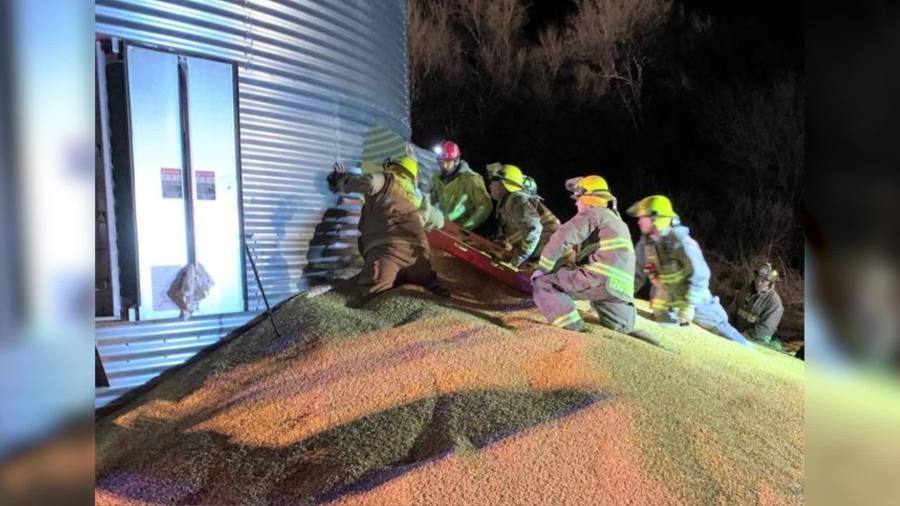SIOUX FALLS, S.D. (KELO) — Grain bins, silos and silage piles can be potentially dangerous areas to work on farms.
Farmers can reduce the potential danger by wearing a safety harness and using a lifeline while working in those areas, Rocky Harmon of the South Dakota Farmers Union and John Keimig of South Dakota State University Extension.
Farmers and ranchers in South Dakota may be inclined to enter a grain bin or silo alone because of time and other demands, Keimig said.
“If you must enter alone, let somebody know,” Keimig said.
Farmers need to tell a friend or family member when they enter the structure and then, call that friend or family member to tell them they are out of the structure, Keimig said.
Forman said farmers should not enter alone. The outside person can help with the lifeline if the inside farmer falls or gets into trouble. The person outside can also call for emergency help if it’s needed, Forman said.
The reason why Forman and Keimig said people should use a safety harness while working inside a grain bin or silo is because the surface of the grain and silage inside the structure can change.
Keimig said that when grain is being removed, for example, a bridge can be formed inside the bin. If that bridge drops, the individual will drop with it and “get caught in flowing grain,” he said.
If an individual enters through the top of the grain bin, a harness will keep them from falling too far, he said.
If a person gets sucked into the grain, it’s nearly impossible to get out of it.
Another danger in a grain bin is crusted grain at the top level or on the sides of the bin. That crust can crumble under an individual’s weight and they can get sucked into the grain.
“Another big thing is you are cleaning the bottom of a grain bin, look at the sidewalls,” Forman said. Grain can get crusted on the inside wall of a grain bin. If that crusted grain falls, it can bury the individual, Forman said.
“The person can die or get injured,” he said.
Forman said newer grain bins have better systems than what was available 20 years ago. There is less need to repair or even check systems than years ago, Forman said.
Newer grain bins also have improved stairs with cages so a person can move around inside a grain bin, Keimig said.
Still, harnesses and lifelines, are still needed, Keimig and Forman said.
Potential dangerous gas in silage silos, piles
There aren’t many reasons to enter a silo, Keimig said.
On Sunday, two people were found dead Saturday morning in a silage silo near Volga. The Brookings County Sheriff’s Department said the two people were employees of a company and they were repairing a roof. The two apparently were overcome by toxic gas, according to the sheriff’s office.
Keimig said people may enter the top of the silo if the silo’s blower has caused silage to gather on one edge side. People may enter to level off the top of the silage, he said.
One danger with silage is gas. According to the Brookings County Sheriff’s Office, the two people who died were working in a Harvestore silo. A Harvestore is a brand of silo that would be considered a closed silo.
Keimig said farmers want silage packed as tight as possible to reduce the oxygen which better preserves the quality of the silage.
Nitrogen and carbon dioxide gases are created in a closed silo which can be lethal, according to Penn State Extension. Nitrogen dioxide is more common in conventional silos.
Potentially harmful levels of gases can be created in silage piles or bunkers, Keimig said.
In general, it’s important to know the condition the silage was in when it was placed in a silo or the silage pile, because that can help indicate the gas risks with the silage, Keimig said.
Ventilation before entering and proper gear are safety precautions recommended for entering silos, according to Penn State Extension.
Be careful when using equipment
Forman said farmers must make sure their power-take-off shifts are covered and that augers are covered. Equipment should be properly working, Forman said.
Simple things like stopping to pay attention when moving equipment is important because of nearby power lines and other items.
“Make sure your (silage) conveyor systems are working properly,” Forman said.
Taking care of equipment can prevent accidents, he said.
Keimig said farmers need to be cautious when use equipment to build and pack a silage pile. One of the potential risks when removing silage from the pile is that material from the top could fall, he said. Those standing near the pile can be injured if the material falls on them.


